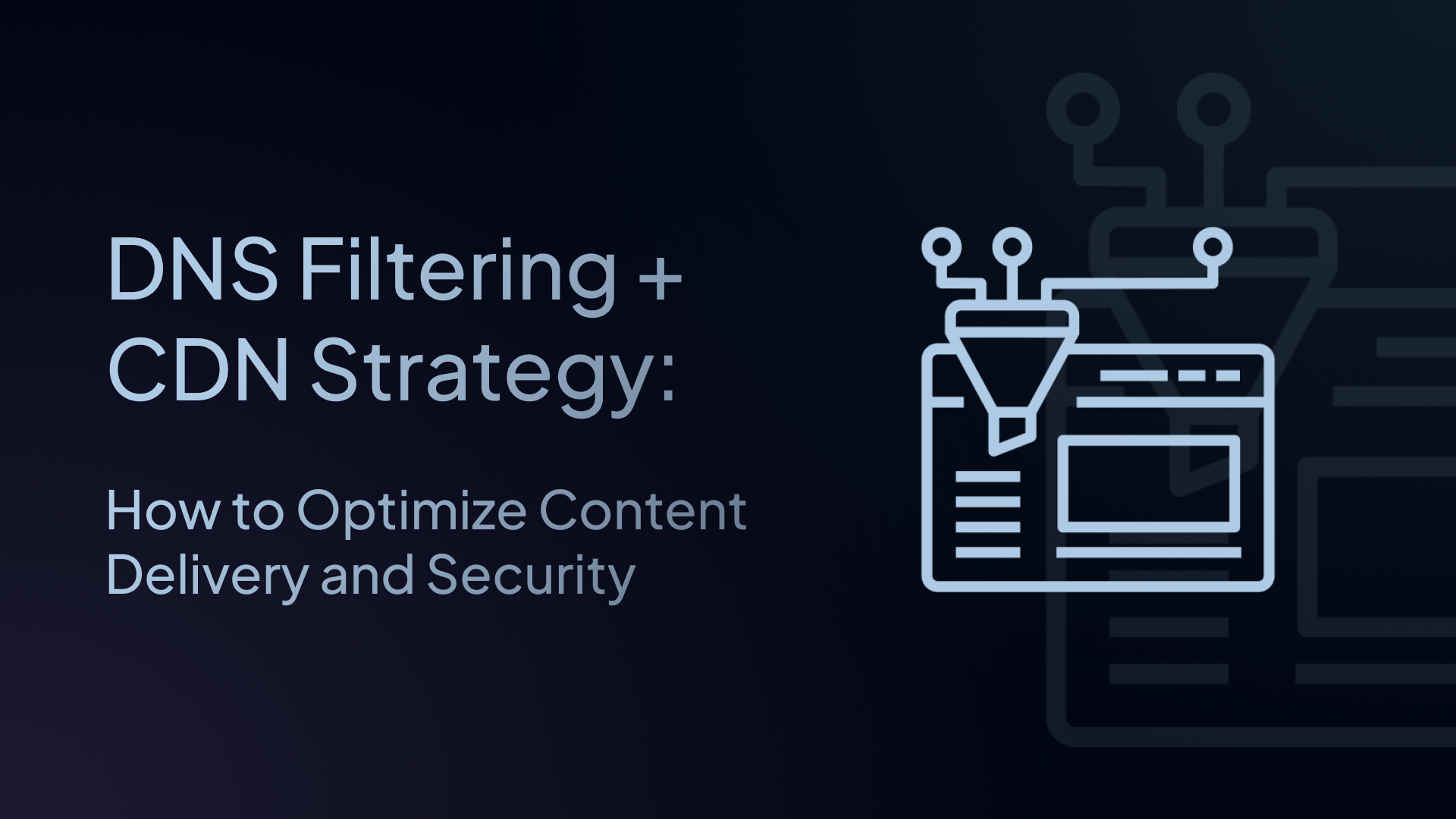DNS Filtering + CDN Strategy: How to Optimize Content Delivery and Security
Discover how DNS filtering enhances CDN performance, blocks malicious traffic, and ensures content reaches users faster.

Every content request starts with DNS, but few teams optimize it.
DNS filtering strengthens CDN strategies by blocking malicious traffic, routing users to optimal edge nodes, and enforcing geo-based rules.
In this guide, we’ll show how DNS filtering supercharges performance, security, and user experience, and why Control D is the go-to solution for industry experts.
What Is a Content Delivery Network (CDN) and Why Does It Matter?
A Content Delivery Network (CDN) is a geographically distributed network of proxy servers and data centers. Its job is to cache and deliver content – HTML pages, JavaScript files, videos, images, etc. – as quickly and efficiently as possible to users, no matter where they are.
CDNs are designed to:
- Reduce latency
- Improve page load times
- Lower bandwidth consumption
- Greater availability and scalability during traffic spikes
- Enhance redundancy and uptime
- Defend against DDoS attacks
However, their effectiveness still relies on another crucial piece of infrastructure: DNS resolution.
How DNS Resolution Impacts Content Delivery
Before a CDN can serve content, your browser needs to know where to fetch it from. This happens at the Domain Name System (DNS) layer. DNS translates human-readable domain names (like yourdomain.com) into IP addresses that point to the right CDN edge node.
- A user enters yourdomain.com
- The DNS resolver finds the IP address associated with the domain
- The browser connects to the nearest CDN node to the user
- Content is delivered from cache or origin
But DNS isn’t just about name resolution. It’s the first step in the journey of every single request. A slow or misdirected DNS lookup can drag down performance, cause timeouts, or even route users to malicious sites.
That’s why optimizing the DNS layer is just as important as fine-tuning your CDN edge nodes. This is exactly where DNS filtering can make an impact.
What Is DNS Filtering?
DNS filtering is the process of using policies and threat intelligence to control which domains can be resolved via DNS. It can:
- Block malicious domains (phishing, malware, C2)
- Prevent access to unwanted or harmful content
- Enforce compliance with corporate internet use policies
- Route DNS queries to specific endpoints for optimization*
Think of it as a smart firewall for DNS traffic. By filtering DNS queries before they resolve, organizations can reduce attack surfaces, enforce security policies, and even improve routing efficiency.
*Note: While most CDNs handle edge selection via DNS, DNS filtering lets you override or fine-tune that behavior by directing DNS queries to specific endpoints or rerouting them based on geography, time, or device identity.
Why CDNs Alone Aren’t Enough
CDNs handle content distribution. But they don’t control how DNS requests are resolved or which IPs are allowed through at the DNS level. Here's where CDNs fall short:
- No filtering: CDNs can’t stop DNS requests to malicious or unwanted domains.
- No policy control: CDNs don’t allow granular access control for DNS-based rules.
- No visibility: CDNs offer limited insight into DNS-level threats or anomalies.
- Latency blind spots: CDNs may deliver from suboptimal endpoints due to poor DNS routing.
DNS filtering adds a much-needed layer of control and intelligence before the CDN even gets involved.
DNS Filtering Benefits: Boost Speed, Reduce Risk, Enforce Control
| Challenge | CDN Limitation | DNS Filtering Benefit |
|---|---|---|
| Bots scraping CDN assets | No access control | Blocks at DNS before traffic hits CDN |
| Slow 3rd-party scripts | CDN serves them, but can't stop them | DNS filters or redirects bad domains |
| Poor geo routing | Depends on DNS/ISP pathing | Enforce custom routing logic |
| API abuse | No proactive gatekeeping | DNS whitelisting and rate control |
| Lack of visibility | CDN logs limited to hits/errors | DNS logs add user/device insights |
1. Preventing CDN Abuse and Shadow Traffic
When your content is delivered via CDN, it’s exposed to the world – and not just to your customers.
Common Abuse Vectors:
- Bots hammering CDN endpoints
- Credential stuffing attacks on login pages
- Scrapers pulling content via public CDN URLs
- Malicious redirection to your CDN resources
DNS filtering helps control who can access your CDN and when.
2. Improving Load Times by Eliminating Bad Third-Party Calls
Many websites rely on third-party scripts, fonts, ad trackers, and analytics, often hosted on CDNs. But not all third-party content is created equal.
Slow or unoptimized third-party calls can:
- Add seconds to page load time
- Block rendering in the browser
- Introduce privacy or compliance issues
- Leak data through unsecured connections
DNS filtering can block or redirect non-essential third-party domains, helping pages load faster and improving core web vitals.
3. Enabling Geo-Specific CDN Routing
CDNs usually resolve to the nearest edge location, but in some cases, due to DNS routing or ISP behavior, users might not hit the most optimal node.
DNS filtering can help enforce custom routing policies, such as:
- Forcing users in specific regions to resolve to a preferred CDN endpoint
- Redirecting DNS queries based on time-of-day or business hours
- Redirect internal requests to internal cache nodes
This level of control ensures your content reaches users via the fastest, most efficient path, especially in regions with inconsistent ISP routing.
4. Protecting APIs and Dynamic Content via DNS Access Control
APIs and dynamic services often use CDN infrastructure for caching or acceleration, but they also become targets for abuse.
Without DNS control:
- Bots can call your API 24/7
- Internal services may be exposed publicly
- Rate-limiting becomes reactive, not proactive
5. Visibility Into DNS Behavior Across CDN Assets
DNS filtering platforms offer deep insight into:
- Which CDN domains are being accessed
- How often is content being requested
- Which devices or users are hitting specific endpoints
- Where errors or latency originate
By combining DNS logs with CDN analytics, you gain a full-spectrum view of your content delivery:
- Troubleshoot performance dips
- Audit content access by department or user group
- Detect unusual patterns (e.g., bots, scraping, malware callbacks)
Choosing the Right DNS Filtering Solution for Your CDN
When evaluating DNS filtering platforms to integrate with your CDN strategy, look for:
- Custom DNS routing support
- Granular policy enforcement capabilities
- Global redundancy and high uptime SLAs
- Real-time logging and analytics
- Seamless compatibility with leading CDN providers
- Easy deployment and management
Control D: A Smarter DNS Layer for CDN-Backed Content
Control D is a next-gen DNS filtering platform designed for flexibility, performance, and security. Unlike traditional DNS services that only resolve domains, Control D locks down your CDN surface area, optimizes performance, and enforces granular access policies at the DNS layer.
Here’s how Control D addresses each blind spot in your content delivery strategy.
1. Block Malicious Traffic Before It Hits Your CDN
Control D’s native Filters block malicious and unwanted traffic, such as malware, phishing attempts, and botnets, at the DNS level. This ensures only legitimate content requests reach your CDN, not DNS-based attacks targeting your CDN infrastructure. You can:
- Block known malicious or low-reputation domains
- Prevent access to content categories like adult, gambling, or crypto-mining domains
- Maintain compliance with regional content regulations
This helps prevent malicious traffic from reaching origin servers, allowing you to offer a more stable and secure content delivery.
2. Cut the Fat from Third-Party Overhead
Slow third-party scripts and trackers can add precious seconds to your page loads, even when served via reputable CDNs. With Control D, you can identify and block underperforming or privacy-invasive third-party domains before they ever get requested.
Filter out unnecessary analytics, ads, or social embeds that bloat your site. This results in faster page loads, better UX, and cleaner compliance — all without touching your front-end code.
3. Custom DNS Routing Rules
With Control D, you can direct traffic originating from specific services, domains, or locations to designated CDN nodes.
For example, you can create granular rules like:
- “Redirect all *.cdn.example.com traffic in Europe to CDN A”
- “Block access to analytics.*.com for guest Wi-Fi networks”
- “Route all media-heavy domains via a low-latency node for APAC users”
This allows for efficient load balancing and can improve the speed and reliability of content delivery by ensuring your users always connect through the most efficient path, no matter what their local ISP decides.
4. Lock Down API Access at the DNS Level
Control D introduces DNS-level access control for APIs, letting you whitelist known client networks or restrict access by geography. Internal endpoints can be made invisible to the public internet, while external APIs get protected from scraping, overuse, or brute-force probing – all before a single packet hits your backend.
5. Analytics for Actionable CDN Intelligence
With real-time DNS logging and analytics, you can track which CDN-hosted domains are being queried, by which users or devices, and how often.
Combine this with your CDN metrics, and you unlock full-stack visibility – perfect for troubleshooting performance issues, spotting bot behavior, or auditing content access across teams or regions.
6. Global Anycast Network with Low Latency
Control D runs on a worldwide Anycast network, which ensures:
- Low-latency resolution
- High availability even under load
- Consistent, reliable performance regardless of user location
This complements your CDN’s edge network and ensures that DNS isn’t the bottleneck in your content pipeline.
7. Easy Setup
Control D can be deployed in minutes with no proprietary hardware or agents. It works with any CDN or network architecture and scales as you grow.
Final Thoughts
In the race to deliver the fastest, most reliable content experiences, every millisecond counts. While CDNs handle the heavy lifting of caching and distribution, DNS is the gatekeeper. And with DNS filtering, you gain granular control over that gate.
Control D gives you full visibility, custom routing, and DNS-level control so you can block threats, boost delivery speed, and take full advantage of your CDN investment.


